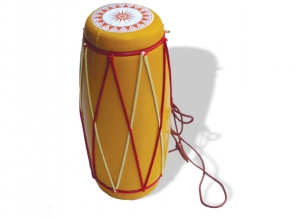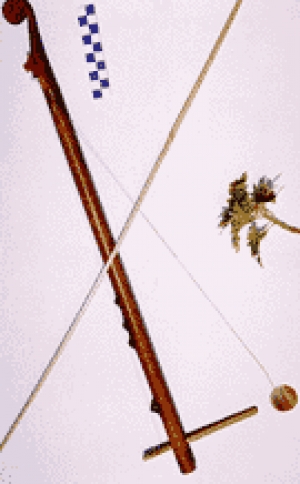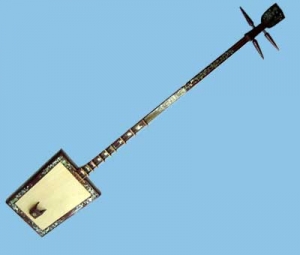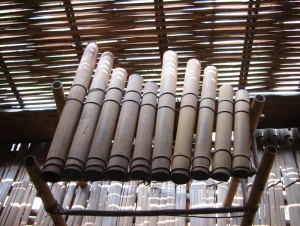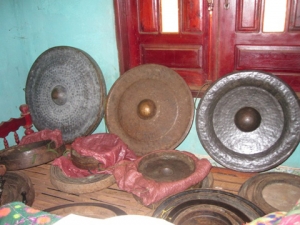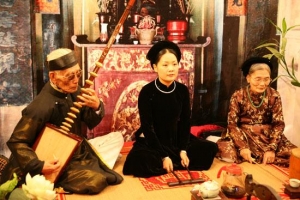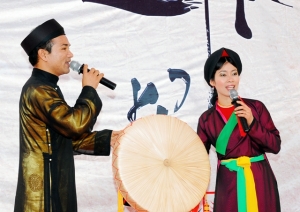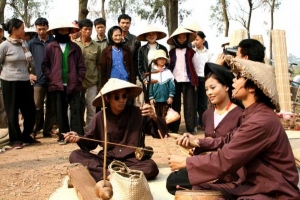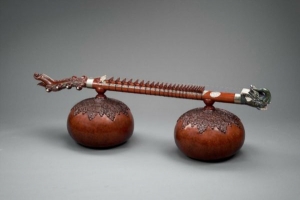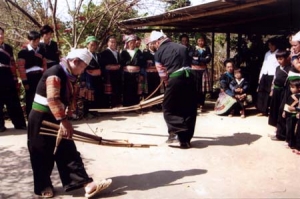
Asia Pacific Travel Team
The Trong Com
The trong com (rice drum) gets its name from the practice of placing a pinch of hot steamed rice in the middle of the drum skin to "tune" the instrument. The trong com onsists of a hollow cylinder or hemisphere with a membrane stretched tightly over one or both ends, played by beating with sticks.
The player, when standing, has the trong com slung over his stomach. When sitting he rests his instrument on his lap. He strikes the faces of the drum with his fingers with varied style.
The sound obtained from one face is five tones higher than the other. The sound of the trong com is a little dull, somewhat similar to the large-sized dan ho, and it is used to express sadness.
The trong com is one of the percussion instruments used to accompany tuong or cheo drama. Its use has also spread to cai luong (reformed opera) and other orchestras.
Dan K'Ni
The K'Ni is a stringed musical instrument, sawing bow branch and is popular among many ethnic minority groups living in northern highlands (central Vietnam) such as Bahnar, Gia Rai, E De, Se Dang, Pako, and Hre...
The most notable particularity of K'Ni is that it has no resonator. The whole K'Ni is a round or straight branch of bamboo section about 50-70 cm in length, 02-03 cm in diameter. Frets (made of beeswax knobs) are fixed on the main part and the string is hung along its length. The bow is made of a small thin bamboo bar; the player rubs the outside of the bow on the string to produce sounds.
Though its structure is quite simple, the distinctiveness of this instrument resides in the way it is played. The player holds a thread that is linked to the string in his mouth to amplify and transform the sounds. While bowing the string and touching the frets to produce pitches, the player changes the aperture of his mouth according to the tune. Thus, the sounds are altered, almost evoking human pronunciation. However, in reality, the pitch of the sound is not standard. The reason is in the nature of half playing and half singing of the sound produced by the K'Ni. Fast changes of the musician's mouth shapes created by soft mouth membrane doesn't allow standard overtone spectrums and sound waves. Yet, those who are familiar with the sounds of the K'Ni and who understand the vernacular may catch the message of the tune. This is why people say that the K'Ni sings. The E De have added cho nac narration (type of song) to K'Ni to replace human voice.
The K'ni is a musical instrument for men to play in communal houses in ethnic minorities' hamlets or in watch-towers in milpa land. In old times, people never used to play it at home considering that with its mystical sound, the K'ni is a speaker of spirits.
Dan Day
Dan Day is a special instrument of Vietnamese origin. This three-stringed lute is used incorporate the peculiarities of the two-stringed lute (dan Nguyet), the four-stringed pear-shaped lute (dan Ty Ba), and the three-stringed lute (dan Tam).
In the past, the dan day was an accompanying instrument used only for one genre of songs, which later divided in two variants known today as hat cua dinh and hat a dao.
The dan day, exclusively played by men, most probably came into being in the 15th century when musical genres were forming. Mostly the Dan Day is used in the northern parts of Vietnam. Its sound box is a trapezoid shape but without a back surface. This bass instrument has high frets and a very long neck. The frets are fixed on the lower part of a very long neck. Its 3 plastic strings produces a low sounds and the Dan Day is only used to accompany the songs performed by female singers.
Apart from accompanying hat cua dinh and hat a dao songs, the dan day is now used to accompany poems as well. Thanks to the unusual technique called ngon chun (slacking the string with the fingers), players may lower the tones and produce refined and modest sounds, it is sometimes compared to a secluded philosopher.
The Klong Put
The Klong put is the Xe Dang language name of a musical instrument of the wind family, air driving-in branch. It is played by ethnic groups in Tay Nguyen (Central Highlands) such as the Xe Dang, Bahnar, Gia Rai, Hre, etc.
A traditional Klong put consists of many large empty hornless bamboo sections. The length of each section ranges from 60 to 200 cm and a diameter ranging from 5 to 8 cm.
This woodwind instrument is intended for women. When played, the tubes are laid horizontally and the player must either stand with her back bent or kneel while clapping her hands at a distance of about 10cm to push air into the tubes to produce sounds. Generally, each tube produces only one tone. However, some ethnic groups use the hand to block one end of the tube to produce some different pitches. With this technique, a two-tube Klong put can produce four or five pitches. The Klong put can also be played by two girls at a time.
Ethnic minority people often play the Kong put on the milpa land during the rice planting time and on the day of closing doors of rice storage. It is believed that hornless bamboo or ordinary bamboo sections of the Klong put are related to those used for containing breed seeds. This belief seems somewhat reasonable because they both give the same sounds when being blown with air. In the breed seeds is existing the spirit of "Mother Rice". Therefore, if the Klong put is played on the milpa land during the planting time, "Mother Rice" will come and help rice grow rapidly. If one plays the Klong put on the day of closing doors of the rice storage, "Mother Rice" will come along and sleep all winter in the storage, then when the next planting season comes, she will come together with seeds to the milpa land.
Cong Chieng
The Cong Chieng is a kind of musical instrument casted from mixed copper and belongs to the idiophonic family. In Vietnamese language, the word "Cong" points to a musical instrument with a bossed part in center (bossed gong) and "Chieng" without it (flat gong).
Ca Tru
Ca tru music sounds strange to the uninitiated. Clicks and clacks accompany the centuries old ballads. It is not the kind of music that inspires toe tapping or humming.
Originally, ca tru was also called hat a dao or hat noi (literally song of the women singers). Attractive young singers entertained men in a relaxed environment, sometimes serving drinks and snacks. Men might have visited a hat a dao inn with friends to celebrate a successful business deal or the birth of a son.
Ca tru flourished in the 15th century in northern Vietnam when it was popular with the royal palace and a favorite hobby of aristocrats and scholars. Later it was performed in communal houses, inns and private homes. These performances were mostly for men. When men entered a ca tru inn they purchased bamboo tally cards. In Chinese, tru means card. Ca means song in Vietnamese, hence the name ca tru: tally card songs. The tallies were given to the singers in appreciation for the performance. After the performance each singer received payment in proportion to the number of cards received.
Ca tru requires at least three performers. The singer is always a woman and plays the phach, an instrument made of wood or bamboo that is beaten with two wooden sticks. A musician accompanies the singer on the dan day, a long-necked lute with three silk strings and 10 frets. There is also a drummer or trong chau.
The drummer shows his approval of the singer or the songs depending on how he hits the drum. If he likes a song he might hit the side of the drum several times. If he is disappointed with the singer, he hits the drum twice. The guitar player must follow the rhythm of the phach. His instrument, the dan day, is only used in ca tru and is now made almost exclusively for sale to tourists who find the shape intriguing.
Quan Ho
The folk-song Quan Ho, a very rich and beautiful musical storehouse of our people, has a very long lasting history. During all its existence, successive creations have unceasingly changed the type of the folk-song Quan Ho.
Today, there are "Quan Ho dai", "New Quan Ho", "the renovated Quan Ho". This shows that there may be some kinds of Quan Ho that are not real Quan Ho. Thus, from what epoch has the tradition of Quan Ho dated?

One of the old polular tales narrates as follows: Once upon a time, Lung Giang village (Liem village) and Tam Son village (Tu Son), both in Bac Ninh province, were in very good relations. Every year, on the 13th of the first lunar month, Tam Son village held a singing party at the communal house and invited five or six elderly men and five or six elderly women together with a great number of young singers of Lung Giang to come to join them. At the festival came into being a form of dialogue. Alternately, each time the young man of one of the villages had sung, the girls from the other village would reply in singing. Such singing competitions lasted all night until the morning of the following day. However, it's asserted that only under the Ly dynasty (1009-1225) did the folk-song Quan Ho begin to develop strongly and become joyful festivals lasting as much as half a month.
 People of ancient times narrated as follows: Although their capital had been established in Thang Long, every year at springtime the Ly Kings always returned to their native locality, Kinh Bac, to hold joyful festivals. Each time, the fleet of dragon boats of the king entered Thien Duc river (or Duong river), the kindred and officials (Quan Vien Ho) of the Ly family, including children, the elderly, young men and young girl, all stood on the two banks of the royal canal which is reserved to welcome royal dragon boats. They sang hymns of praise, claping their hands and sang songs praising the king to the rhythm of the boat's oars and to the rhythm of the castanets of the Chief Rower. The king often gave a special traditional feast, granted money, silk and opened a official sanity party who recited poems and sang. Since then on, this kind of folk-songs bears the name of Quan Ho songs, or the songs of the Officials and the Kindred.
People of ancient times narrated as follows: Although their capital had been established in Thang Long, every year at springtime the Ly Kings always returned to their native locality, Kinh Bac, to hold joyful festivals. Each time, the fleet of dragon boats of the king entered Thien Duc river (or Duong river), the kindred and officials (Quan Vien Ho) of the Ly family, including children, the elderly, young men and young girl, all stood on the two banks of the royal canal which is reserved to welcome royal dragon boats. They sang hymns of praise, claping their hands and sang songs praising the king to the rhythm of the boat's oars and to the rhythm of the castanets of the Chief Rower. The king often gave a special traditional feast, granted money, silk and opened a official sanity party who recited poems and sang. Since then on, this kind of folk-songs bears the name of Quan Ho songs, or the songs of the Officials and the Kindred.
Each year, on the 13th of the 1st lunar month, on the Lim hills or in the Lim pagoda's park, among the blossoming peony bushes, the pilgrims come from every corner of the country and distinguished and smart young men and young girls of the region gather for sight seeing, contemplating blossoming flowers, encountering and making acquaintance with each other and listening together to recitals of songs, or sing Quan Ho songs.
Coming Lim festival in groups of young men or women, Quan Ho singers are dressed in their best clothes, men carry with them an umbrella of black silk, women a fan under a cartwheel palm-leaf hat tucked under their arms. A female group may be the first to go up to a male group and offer betel quids, thus striking up an acquaintance. A dialogue begins in the form of songs. In any event, courliness is the rule. The men call themselves "Your younger bothers" and address the women as " Our elder sisters"; conversely, the latter call themselves "Your younger sisiters" and address the former as" Our elder brothers". Female duets keep up the conversation by exchanging songs with male duets.
For instance, if the female group sing:
"How dare we! You elder brothers are like the moon that shines in the sky, we your younger sisters, we are but tiny lamps lighting small cottages".
The men will answer unpretentiously:
"Please be the first to sing, elder sisters, we'll follow suit".
Xẩm - a Vietnamese classical form of music
Xam singing, a Vietnamese form of art aged centuries, has always been preserved as the nation’s delicate piece of culture to be admired by numerous tourists.

A show performed by old artists
Let’s turn back time to the old days to the legend attached to this special kind of art. The legend, which has been handed down from generation to generation, tells that Xam singing was invented by Tran Quoc Dinh- a children of King Tran Thanh Tong around 700 years ago. According to this legend, the King was humane and upright and had the good relationships with the poor. He taught them how to play the instrument, and how to sing in order to milden hardships in life.
Main traits. “Hat Xam” or “Xam singing” has been mainly found in the countryside, and, expressed the optimism and love for life of the blind. They were mostly settling in in Ninh Binh, Nam Dinh, Hai Duong, Bac Giang, Ha Noi… In the past, Xam singing was performed during leisure period of time after the harvest crops. The farmers used to invite Xam troupes to come and perform in their village so that their families could enjoy their repertoire of music. In the wartime or poor crops, Xam singers could not earn enough locally to earn for a living, thus they traveled to many places to sing for a better income. Many of them flocked to big cities, including Hanoi. Crowded trams, car stations, markets and street corners were the stages for these singers, or somehow, artists. In Xam singing, one plays drum, one plays castanets, one plays Nhi/Co fiddle, one plays Bau mono chord and all sing together with Southern or Northern accent. To thank and encourage Xam singers for their well performing, the audiences, both men and women; children and adults gather for enjoyment and then hand them some money.
You may wonder if there is any difference between a band in the past and that of today. There’s almost no big difference. The only note is that the new style of Xam singing developed on the basis of the traditional forerunner in rural areas,

..and performed by street artists
but it had quick and ornate rhythms, which differ the traditional Xam played in the countryside, suitable for the busy atmosphere of the city and high educated people.
Where to catch a show in Hanoi? If you have special interest in Vietnam’s traditional art, we suggest that you wandered along Hanoi’s Old Quarter, such as Hang Ngang, Hang Dao. On your way, you can find and have chances to enjoy a Xam singing show. Popular poems, particularly those full of folk characteristics by poet Nguyen Binh, such as Lo buoc sang ngang (A Girl’s Anxiety before Marriage), Giang sang vuon che (Moonlight on Tea Garden), Em di tinh ve (A Girl’s Return after a Province Trip), are used in a certain shows.
In fact, Xam was not only performed at stations and markets, but also appeared in folk performances, lullabies, music for funerals, Ca tru (ceremonial songs), etc. Together with the clanging rhythms of the trams which were once a common means of transport in Hanoi, Xam singing became familiar to the city dwellers.
The Gong Zither
The gong zither is a stringed musical instrument of flipping branch. It is popular among some ethnicities in the North of the Central Highlands such as Bana, Gia Rai, Xe Dang, Ro Ngao, Je Trieng.
The special instrument often accompanies its player to the field, to festivals held at the communal long-house, or to a meeting place where the player reveals his feelings to his lover.
The body of the gong zither is made of a hollow bamboo pipe which is closed by its natural nodes. Attached at one end of the tube is a sound box made of a dried gourd; pinned to the other end are bamboo bolts used to hang the 10 to 18 strings.
The gong zither is a musical instrument for men. The player skillfully puts the bottom of it onto his bell and and direct the neck of the gong forward. He snaps his fingers on the strings to create vibrations full of resonance. The gong zither can produce a variety of sounds, so it can be played instead of a small music band.
H'mong Pen Pipe
The Pen-pipe is a musical instrument of the wind family with the free vibrated reed, popular among almost all of Vietnam's ethnicity in different forms.
This musical instrument is called Khen by The Kinh (Viet) group, while the Mong ethnic minority call it the Kenh, and the Ede in the Central Highlands use a similar instrument called Dinh Nam, etc.
The Pen-pipe may have an evennumber of 6, 8, 10, 12 and 14 sections of small hornless bamboo pipes arranged in two rows. Each pipe is fitted with a reed made of a thin strip of copper. The section of the pipes with the reed lies inside the wooden air-chamber. The part of the pipe lying outside it shows a finger-hole. The pipe into which the player blows lies at right angles with the pipes with finger holes.
The pitch of The Pen-pipe's sounds depends on the the length of each section. The sound of The Pen-pipe is not very clear but quite strong, nonetheless; the deepestnotes are rather dull. Special melodies for The Pen-pipe among ethnicity are composed in the style of homophony.
The Pen-pipe is a musical instrument for men and is used mainly to accompany singing. The H'Mong minority group play The Pen-pipe on various occasions, including funeralswhere it is accompanied by drums. When The Pen-pipe is played by one person, the soloist accompanies the music with dancing in which much vigorous knee-bending, body-turning, kicking, etc., is performed.


